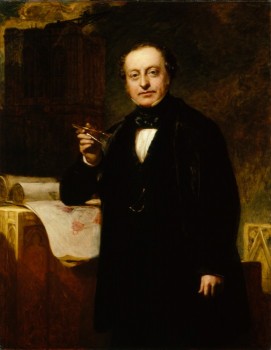My time on the St Stephen’s project has been fascinating. I knew very little about the Chapel itself before coming to the project and I am immensely grateful for having had the opportunity to learn about this amazing building and its legacy. What continually struck me throughout my research on the project was the degree of meaning that antiquaries, architects, and interested amateurs found in St Stephen’s. In the mid-nineteenth century, the opinion one held regarding St Stephen’s, and Gothic architecture in general, was not merely an aesthetic one; it might almost be a clue to one’s views on ancient learning, on religion, on national history, on civilisation itself.

That’s why I was particularly keen to know what the numerous architects who submitted designs for a rebuilt Palace of Westminster after the 1834 fire intended to do with what remained of St Stephen’s Chapel. The Committee in charge of choosing a new design had recommended that the surviving ancient buildings, Westminster Hall and St Stephen’s, should be retained if at all possible, but each architect dealt with St Stephen’s slightly differently. Some were insistent that the ancient would be integral to the modern scheme. As C.R. Cockerell said of his design, “All antiquities, as sacred in English breasts... are preserved as records of their respective periods – more eloquent than histories.” Other designs were less wedded to the necessity of retaining St Stephen’s. W.S. Inmann wrote equivocally of his, “If rebuilding St Stephen’s be indispensable, this design would admit of its restoration without much disarrangement…” Generally speaking, architects were in favour of restoring the Chapel it to its former glory, whether as a public gallery (not unlike the modern St Stephen’s Hall), a library, or a place of worship. But, after centuries of use and the final fatal fire, it seems likely that St Stephen’s was simply unsalvageable by 1837, when Barry began construction.
I was also interested more generally in the discussion around architectural styles. (As a complete architecture neophyte, I’ve thoroughly enjoyed the crash course I’ve had to give myself.) It was particularly interesting to learn that the Committee had stipulated that all proposed designs must be in either “Gothic or Elizabethan” style – evidence that the enthusiasm for the Gothic was no longer recherché, or fatally tainted by the whiff of crypto-Catholicism, but mainstream. I wasn’t surprised to find that the rebuilding of the Houses of Parliament, and the standing remnants of St Stephen’s Chapel, invited some patriotic effusions from architects and antiquaries who viewed the Gothic as part of Britain’s heritage – and future. As one architect who submitted a Gothic design, James Pennethorne, put it: “[Gothic] architecture is believed by many to have originated in England: it undoubtedly was rendered a science and perfected in this country; it is the most congenial to our climate and feelings, and may be considered essentially NATIONAL.” For Henry Dudley Ryder, an antiquary and churchman equally supportive of a Gothic-style Palace of Westminster, the 1834 fire had been nothing short of a divine decree that St Stephen’s must be restored to its original purpose as a place of worship. In doing so, the example of St Stephen’s would not only raise the quality of British architecture above that of other nations (very important), it would also act as “the model for a senate house of a great empire”.

There were, however, some who objected to the absurd interest shown by otherwise “civilised” people in such a “barbaric” style as Gothic. Whatever one’s view, one can’t help but sympathise a little with poor William Wilkins, who submitted a design to the competition – then swiftly published an apology for it. His own design, in the Tudor style, was thought too “homogenous”, a word that gave Wilkins much offence. This, he believed, was the Commission’s way of saying they wanted the finished building to look ecclesiastical, even though its purpose was civil – a fatuous effect achieved by Barry’s Gothic design. What would be next? The Lord Chancellor in a cardinal’s hat?
Wilkins’s “Apology” pamphlet was a veiled personal attack on Edward Cust, who sat on the Committee, and on other “amateurs” whose smattering of learning gave them pretensions. It’s an impressively dyspeptic document; every word drips with sarcastic ire. In fact, the rebuilding of the Houses of Parliament occasioned some of the most sharply barbed polemics I’ve seen. For instance, Wilkins, referring to Cust and the imagined amateur: “with all the taste he pretends to, [he] dislikes Grecian architecture. I have no quarrel with him on this score: it is not every mind that is sufficiently enlightened to appreciate the beauty of its form and proportions...” Ouch. And then there was James Savage, who thought Committees of Taste to be assemblies of “ignorant old women”...
But, angry architects and antiquaries aside, the point to take away from this is that people were passionate about St Stephen’s, about style, art, and architecture, and above all about the meaning of places and buildings. In my own dyspeptic antiquarian way, I can’t help but be reminded of a recent pronouncement on The Shard: it represents nothing but itself. Such a meaningless “icon” would never have passed muster with Victorian tastes.
Anyway, I leave the project with an immense respect for what the team are undertaking to do. I see this project as a direct legacy of the efforts made by antiquaries in the nineteenth century to expound the value of St Stephen’s Chapel; they saw it as shaping the political culture of Great Britain. This it undoubtedly did, and future outputs from this project will make that clear. But St Stephen’s can also show us how Britain’s historical remains have been variably destroyed, neglected, cherished, studied, and appreciated over time. The Virtual St Stephen’s project is the latest effort in a long tradition of scholarly engagement with St Stephen’s, one of the most important buildings in British history. Invisible though it is, it is not lost.





